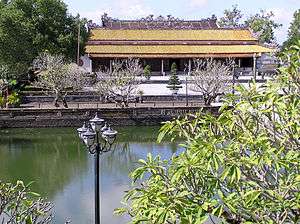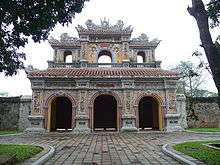Imperial City, Huế
| Complex of Huế Monuments | |
|---|---|
| Name as inscribed on the World Heritage List | |
 Hall of Supreme Harmony | |
| Type | Cultural |
| Criteria | iv |
| Reference | 678 |
| UNESCO region | Asia-Pacific |
| Coordinates | 16°28′11″N 107°34′40″E / 16.46972°N 107.57778°ECoordinates: 16°28′11″N 107°34′40″E / 16.46972°N 107.57778°E |
| Inscription history | |
| Inscription | 1993 (17th Session) |
The Imperial City (Vietnamese: Kinh thành Huế) is a walled fortress and palace in the city of Huế, the former imperial capital of Vietnam.
Characteristics
The grounds of the Imperial City are protected by fortified ramparts 2 kilometers by 2 kilometers, and ringed by a moat. The water in the moat is routed from the Huong River (Perfume River) through a series of sluice gates. This enclosure is the Citadel (Kinh thành). Inside the Citadel is the Imperial City (Hoàng thành), with a perimeter wall some 2.5 kilometers in length. Within the Imperial City is the Purple Forbidden City (Tử cấm thành), a term similar to the Forbidden City in Beijing. Access to the innermost enclosure is restricted to the Nguyễn imperial family.
History
.jpg)
In June 1802 Nguyễn Ánh took control of Vietnam and proclaimed himself Emperor Gia Long. His rule was recognized by China in 1804. Gia Long consulted with geomancers to decide which was the best place for a new palace and citadel to be built. After the geomancers had decided on a suitable site in Huế, building began in 1804. Thousands of workers were ordered to produce a wall and moat, 10 kilometers long. Initially the walls were earthen, but later these earthen walls were replaced by stone walls, 2 meters thick.
The citadel was oriented to face the Huong River to the east. This was different from the Forbidden City in Beijing, which faces south. The Emperor's palace is on the east side of the citadel, nearest the river. A second set of walls and a second moat was constructed around the Emperor's palace. Many more palaces and gates and courtyards and gardens were subsequently added. The reigns of the last Vietnamese Emperors lasted until the mid-1900s. At the time, the Purple Forbidden City had many buildings and hundreds of rooms. It suffered from termite and cyclone damage, but was still very impressive. Many bullet holes left over from the Vietnam War can be observed on the stone walls.
In the early morning hours of January 31, 1968, as part of the Tet Offensive a Division-sized force of North Vietnamese Army and Viet Cong soldiers launched a coordinated attack on Huế seizing most of the city. During the initial phases of the Battle of Hue, due to Huế's religious and cultural status, US troops were ordered not to bomb or shell the city, for fear of destroying the historic structures; but as casualties mounted in house-to-house fighting these restrictions were progressively lifted and the fighting caused substantial damage to the Imperial City. Out of 160 buildings only 10 major sites remain because of the battle, such as the Thái Hòa and Cần Thanh temples, Thế Miếu, and Hiển Lâm Các. The city was made a UNESCO site in 1993. The buildings that still remain are being restored and preserved. The latest and so far the largest restoration project is planned to conclude in 2015.[1]
Layout
.jpg)

Imperial City Gates
- Cửa Đông Nam (Southeast Gate), also called cửa Thượng Tứ
- Cửa Chính Đông also called cửa Đông Ba
- Cửa Đông Bắc (Northeast Gate) also called cửa Trài or cửa Mang Cá nhỏ
- Cửa Chính Bắc (cửa Hậu/cửa Mang Cá lớn)
- Cửa Tây
- Cửa Thể Nhân (cửa Ngăn)
Forbidden City Main Gates
- Cửa Ngọ Môn
- Cửa Hòa Bình
- Cửa Chương Đức
- Cửa Hiển Nhơn
Outer Court
- Điện Thái Hòa
- Điện Phụng Tiên
- Cung Trường Sanh
- Cung Diên Thọ
Temples and Places of Worship
- Triệu Miếu
- Thái Miếu
- Hưng Miếu
- Thế Miếu
- Điện Phụng Tiên
- Hiển Lâm Các
Inner Court
- Đại Cung môn
- Tả vu, Hữu vu
- Điện Cần Chánh
- Điện Võ Hiển
- Điện Văn Minh
- Điện Trinh Minh
- Điện Quang Minh
- Điện Càn Thành
- Điện Khôn Thái
- Viện Thuận Huy
- Viện Dưỡng Tâm
- Ngự Tiền Văn phòng
- Lục Viện
- Điện Minh Thận
Gardens
- Vườn Ngự Uyển
Pavilions
- Lầu Kiến Trung
- Thái Bình Lâu
Gallery
 The Imperial City's plan in Đại Nam nhất thống chí
The Imperial City's plan in Đại Nam nhất thống chí Thái Hòa Palace (Hall of Supreme Harmony) beyond the Bridge of Golden Water
Thái Hòa Palace (Hall of Supreme Harmony) beyond the Bridge of Golden Water Thái Hòa Palace and the Court of Ceremony
Thái Hòa Palace and the Court of Ceremony Thế Miếu temple (Temple of Generations)
Thế Miếu temple (Temple of Generations)- Flagtower of Imperial City Huế
- Pond and ornamental rockeries within the Imperial Enclosure
- Guardian Statue
.jpg) Long corridor
Long corridor
References
- ↑ Vietnam to spend 61 million dollars to restore Hue royal citadel. Retrieved 2012-07-26.
External links
| Wikimedia Commons has media related to Citadel of Huế. |


